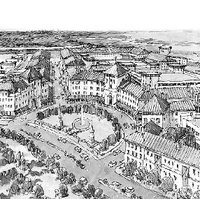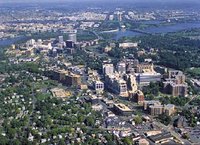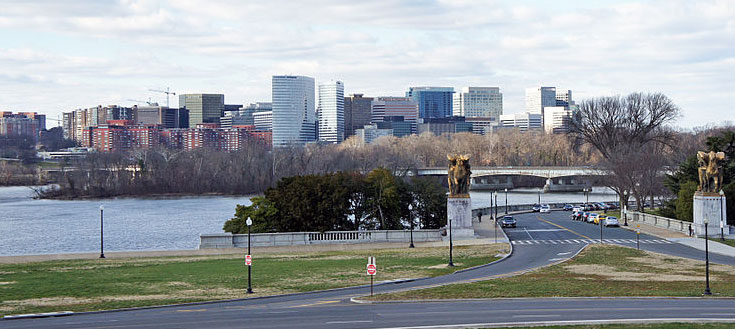Smart Growth
| Topics: |
Smart growth is an urban planning theory that concentrates growth in dense, centralized mixed-use areas in contrast to modern-day urban sprawl, traffic congestion, disjointed neighborhoods, and urban decay. This concept advocates compact, transit-oriented, walkable environments that comprise a mixture of land uses, including neighborhood schools, retail and commercial space, community institutions, and a variety of housing types and styles, within close proximity of one another. It has been employed in various urban and suburban areas throughout the United States and has been found to beneficially affect natural habitats, air and water (Water pollution) pollution, and the preservation of land.
Smart growth values long-range, regional considerations of sustainability over the short-term focus of rapid expansion and growth. Its goals are to achieve a unique sense of community and place; expand the range of transportation, employment, and housing choices; equitably distribute the costs and benefits of development; preserve and enhance natural and cultural resources; and promote public health.
Contents
History of smart growth practices
 Urban Sprawl (Source: National Science Foundation)
Urban Sprawl (Source: National Science Foundation) .
Transportation and community planners began to promote the idea of compact cities and communities in the early 1970s. The cost and difficulty of acquiring land (particularly in historic and/or protected areas) to build and widen highways caused some politicians to reconsider basing transportation planning based around motor vehicles, resulting in the growth management revolution of the 1970s and 1980s. Practices were popularized by architects Peter Calthorpe and Andres Duany in the United States, who encouraged complexes of urban villages and design codes which discouraged driving, along with Colin Buchanan and Stephen Plowden in the United Kingdom.
In the mid-1990s, the American Planning Association launched its “Growing Smart” project, which in 1997 produced the first edition of the Growing Smart Legislative Guidebook: Model Statutes for Planning and the Management of Change. Also in 1997, the Natural Resources Defense Council and the Surface Transportation Policy Project published The Took Kit for Smart Growth, which promoted compact growth, mixed land uses, and transit oriented development. In conjunction with the ascension of smart growth principles amongst planners and US policy makers, the United States Environmental Protection Agency established a network of organizations dedicated to the principles of smart growth in 1996.
The interest in smart growth developments has in part been a response to the environmental and social effects which have resulted from the popularity and expansiveness of sprawling suburban developments. In contrast with the types of development which has pervaded the United States for decadebs, smart growth communities aim to reduce the exhaustion of available land, maximize the profitability of developed land, and encourage greater community involvement and interaction. Furthermore, in areas such as South Florida and San Francisco, where further outward growth and expansion is virtually impossible, smart growth developments are a way to create new development with density and height rather than continued sprawl.
Components of smart growth
Smart Growth America, a national coalition of multiple smart growth advocacy groups lists the following six goals of smart growth:
- Neighborhood livability
- Better access/less traffic
- Enabling pre-existing cities, suburbs, and towns to thrive
- Shared benefits
- Lower costs/lower taxes
- Preserving open space
In accordance with these six goals, the Smart Growth Network has developed ten basic principles to achieving smart growth:
- Mix land uses
- Take advantage of compact building design
- Create a range of housing opportunities and choices
- Create walkable neighborhoods
- Foster distinctive, attractive communities with a strong sense of place
- Preserve open space, farmland, natural beauty, and critical environmental areas
- Strengthen and direct development towards existing communities
- Provide a variety of transportation choices
- Make development decisions predictable, fair, and cost effective
- Encourage community and stakeholder collaboration in development decisions.
The goals of Smart Growth as presented to the public by politicians and planners may vary by context and location, however several themes consistently emerge: preservation of open space, protection of environmentally sensitive areas, and support for further development of existing urban areas (including urban renewal). Its principles also challenge several long-standing assumptions in urban planning and development, such as the higher values associated with detached homes and the national preference for automobile use.
 Traditional Smart Growth (Source: Chapel Hill - Center for Urban and Regional Studies)
Traditional Smart Growth (Source: Chapel Hill - Center for Urban and Regional Studies) The three driving forces behind the themes of smart growth are the creation of compact neighborhoods, a successful combination of multiple uses, and an emphasis on transit-oriented development.
Compact neighborhoods
According to smart growth theorists, creating compact, livable and workable urban neighborhoods will attract more residents, businesses, and patrons to these areas, a key element of reducing urban sprawl and protecting local environments and climates. This concept is often achieved via mixed-use development, the inclusion of affordable housing, ample public park and recreation space (to encourage pedestrian activity), and restrictions or limitations on “suburban” design forms (such as detached homes, private lots, large backyards, strip malls, and expansive surface parking lots). By concentrating activity in smaller, denser areas, smart growth preserves open spaces and animal habitats, reuses already-developed land in a more productive manner, and fosters cleaner air and water supplies.
Mixed-use developments
Mixed-use developments are design to include a number of functions and zoning types in order to enable a variety of different activities within the same general complex or vicinity. These developments often include a combination of residential, commercial, industrial, retail, educational, institutional, and recreational uses, and can vary in size from a single building to a large master-planned community. The primary aim of mixed-use developments is eliminating the need to travel large distances in order to perform daily activities by instead concentrating multiple uses easily-accessible and in close-proximity. In recent years, many large suburban communities have focused on creating new "town centers" mixing multi-family residences, retail shops, and office space in order to maximize the use and profitability of land and increase the tax base of their municipalities.
Transit-oriented development
These compact, mixed-use communities (which tend to encourage the utilization of public transportation at all times of day) can also fall under the term of transit-oriented developments (TODs), areas in which development is concentrated around access to public transportation. Transit-oriented developments are often public-private collaborations between real-estate developers and government transit agencies and are often accompanied by new public transportation infrastructure and regional transit cooperation. Transit-oriented developments are typically built around major transportation nodes, most frequently rail stations, but often include intermodal access between buses, highways, and park-and-ride lots as well. In addition to their focus on mass transit forms (i.e. commuter rail, light rail, bus rapid transit, etc) which are more environmentally-friendly than personal automobile travel, transit-oriented developments are also heavily oriented around biking and walking, which also reduces harmful automobile emissions and may foster a healthier population overall. Pedestrian- and bicycle-friendly improvements include narrower streets, bicycle lanes, an urban bike-trail system, bicycle parking, an emphasis on pedestrian crossings, and separated walking paths.
How do governments affect smart growth?
Local governments predominantly affect smart growth development via local zoning ordinances. Through careful zoning regulations, new development can be restricted to specific areas, land uses can be regulated by location, and additional density incentives can be offered for developing under-productive brownfield and greyfield land. Zoning laws can also reduce the amount of parking required to be built with new development, and can be used to mandate land to be utilized for parks, recreation space, and other community amenities.
Another popular approach is the use of environmental impact assessments, often required of prospective developers by state and/or local governments. These reports project the physical and social impact which new development will have on the surrounding communities and environment, and often indicate how harmful impacts generated by the development will be mitigated - usually via reparations paid by the developer. These assessments are frequently controversial, as conservationists, neighborhood advocacy groups and NIMBYs (individuals opposed to new projects in their own neighborhoods) are often skeptical about the legitimacy of such impact reports, even when they are prepared by independent agencies and subsequently approved by government agencies rather than the real-estate promoters. Conversely, developers will sometimes strongly resist being to the mitigation measures required by the local government for being far too costly and making new projects financially unfeasible.
Examples of smart growth
The United States Environmental Protection Agency has recognized these cities for successfully implementing smart growth principles:
- Arlington, Virginia
- Minneapolis & Saint Paul, Minnesota
- Davidson, North Carolina
- Denver, Colorado
In the City of Arlington, Virginia, officials worked to concentrate dense new residential, commercial, and retail developments around five Orange Line stations on the Washington Metro: Rosslyn, Court House, Clarendon, Virginia Square, and Ballston. Arlington’s plans have resulted in dense, mixed-use, infill development stretching linearly along Wilson Boulevard, Clarendon Boulevard, and Fairfax Drive, particularly in the areas surrounding the five transit stations. Over 21 million square feet of office and retail space, 3,000 hotel rooms, and 22,500 residential units now exist within this vital corridor. In each case, all five of Arlington's pedestrian-oriented “urban villages” gradually give way to lower-density residential neighborhoods on the periphery.
 Transit-oriented smart growth in Arlington, Virginia. (Source: U.S. EPA)
Transit-oriented smart growth in Arlington, Virginia. (Source: U.S. EPA) The Smart Growth Network has also recognized the following examples of smart growth:
- East Liberty; Pittsburgh, Pennsylvania, United States (establishing downtown retail)
- The Kentlands; Gaithersburg, Maryland, United States (for live-work units)
- Moore Square Museums Magnet Middle School; Raleigh, North Carolina, United States (for being located downtown)
- Garfield Park; Chicago, Illinois, United States (retaining transit options)
- New Jersey Pineland; Southern New Jersey, United States (for transfer of development rights away from undeveloped land)
In East Liberty, a predominantly African-American community in Pittsburgh, the city government was able to lure several major national retailers to the outdated community in recent years. Their commercial success to a massive surge in investment and new development, resulting in a resurgence of the neighborhood's busting retail environment. Simultaneously, two of the community's three blighted public housing projects have been demolished, with the third scheduled for demolition in the near future, further signifying East Liberty's transformation.
Environmental benefits of smart growth
The United States Environmental Protection Agency claims, “Smart growth principles can minimize air (Air pollution emissions) and water (Water pollution) pollution, encourage brownfields clean-up and reuse, and preserve natural lands.” In contrast, sprawling suburban development and the reliance on personal automobiles (making an increasingly greater number of trips) can be linked with a scarcity of available and undeveloped land, increased harmful [[air (Air pollution emissions)] emissions], negative effects on global climate change, lower water quality, and damaged or destroyed wildlife habitats.
A number of EPA studies performed across the United States have shown that applying smart growth principles to pre-existing communities has improved air quality (by reducing automobile mileage and emissions), improved water quality (by minimizing paved surfaces and enabling natural rainwater filtration devoid of contamination), and preserved a significant amount of open space and natural lands. Such case studies and evaluations have taken place in locations including Sacramento, Nashville, Atlanta, Southern New Jersey, Seattle, Denver, San Francisco/Oakland, Cleveland, Pittsburgh, Providence, Northern Virginia, Orlando, and Chicago.
In the case of Atlanta infill development Atlantic Station, located on the former site of an Atlantic Steel plant, EPA analysis estimated the potential environmental benefits from locating a “smart growth” development at a redeveloped industrial site near downtown Atlanta versus a traditional suburban development site. The EPA estimates that vehicle miles traveled would be reduced by 15-52 percent, nitrogen oxide emissions would be reduced by 37-81 percent, and volatile organic compounds would be reduced by 293-316 percent. These factors contribute significantly to “ground-level ozone” pollution, better known as smog. Regarding water quality, the EPA found in another case study that smart growth development in New Jersey would reduce water pollution by 40 percent when compared with more dispersed patterns of development. It has also been estimated that the 2 square mile collection of “urban villages” in Arlington, Virginia could consume over 14 square miles of open space at typical suburban densities, demonstrating the potential effects which smart growth patterns can have on land preservation.
On a wider scale, a study performed at Rutgers, The State University of New Jersey projects that in the United States, over a span of 25 years, smart growth could save 3.9 million acres of land, including 1.7 million acres of agricultural land, 91,000 miles of local roadways, and $144 billion in housing costs when compared with “traditional” patterns of growth. In total, smart growth could amount to $250 billion of financial savings in the United States, about 20% of which would benefit state and local governments, with the remaining 80% benefiting real estate developers, and ultimately, commercial tenants, businesses, and homebuyers.
Obstacles to smart growth
The National Center for Public Policy Research's Center for Environmental Justice termed smart growth "restricted growth" and suggested that smart growth policies disfavor minorities and the poor by driving up housing prices, in a 2002 economic study entitled "Smart Growth and its Effects on Housing Markets: The New Segregation.”
Some libertarian groups, such as the Cato Institute, criticize smart growth on the grounds that it leads to greatly increased land values, and people with average incomes can no longer afford to buy detached houses. In addition, the smart growth practice of encouraging citizen participation in land-use decisions increases the ability of homeowners to vote against the creation of affordable housing in their communities.
A number of ecological economists claim that industrial civilization has already "overshot" the carrying capacity of the Earth, and "smart growth" is mostly an illusion. Instead, a steady state economy would be needed to bring human societies back into a necessary balance with the ability of the ecosystem to sustain humans (and other species).
Also, smart growth developments are often far more costly (financially) for developers than typical suburban communities. In addition, some critics indicate that many modern consumers simply prefer patterns of sprawl, privacy, and automobile dependency. There are also very few available plots of land for smart growth development in desirable, transit-rich, and economically-feasible locations. Therefore, much smart growth often occurs in the form of urban infill or urban redevelopment, which is often expensive and controversial. Pre-existing neighborhood residents also often protest massive new developments. In addition, many disputed urban renewal projects of the 1960s and 1970s have made residents increasingly reluctant to support these similar contemporary variants of the movement. Furthermore, mass transit growth and expansion is similarly controversial and expensive.
In addition, many critics claim that the rigidity of smart growth plans increases personal regulations and reduces freedom, and that the density of smart growth developments may actually increase traffic congestion.
 Image by Mario Roberto Durán Ortiz
Image by Mario Roberto Durán Ortiz
References
- Wikipedia: Smart Growth
- Litman, Todd. Evaluating Criticism of Smart Growth. Victoria Transport Policy Institute. 24 September 2007.
- Conflicts Between Smart Growth and Housing Affordability
- O'Toole, Randall. The Folly of "Smart Growth" Thoureau Institute.
- Smart Growth and Its Effect on Housing Markets: The New Segregation. (National Center for Public Policy Research)
- Burchell, Robert W., David Listokin, and Catherine C. Galley. Smart Growth: More Than a Ghost of Urban Policy Past, Less Than a Bold New Horizon. Housing Policy Debate. Rutgers, The State University of New Jersey (821-879).
- About Smart Growth (U.S. EPA)
- Environmental Benefits of Smart Growth (U.S. EPA)
- Effects of Different Development Types on the Environment (U.S. EPA)
- This is Smart Growth: Featured Communities
- Moglen, Glenn E., Steven A. Gabriel, and Jose A. Faria. A Framework for Quantitative Smart Growth in Land Development. Journal of the American Water Resources Association. August 2003 (947-959).
- What is Smart Growth? (Smart Growth America)
- Knaap, Gerrit-Jan. A Requiem for Smart Growth? National Center for Smart Growth Research and Education. University of Maryland.
- Arlington County, Virginia (U.S. EPA)
- Miller, Nancy A. and Jeff Miller. Defining Mixed-Use Development. University of Minnesota.